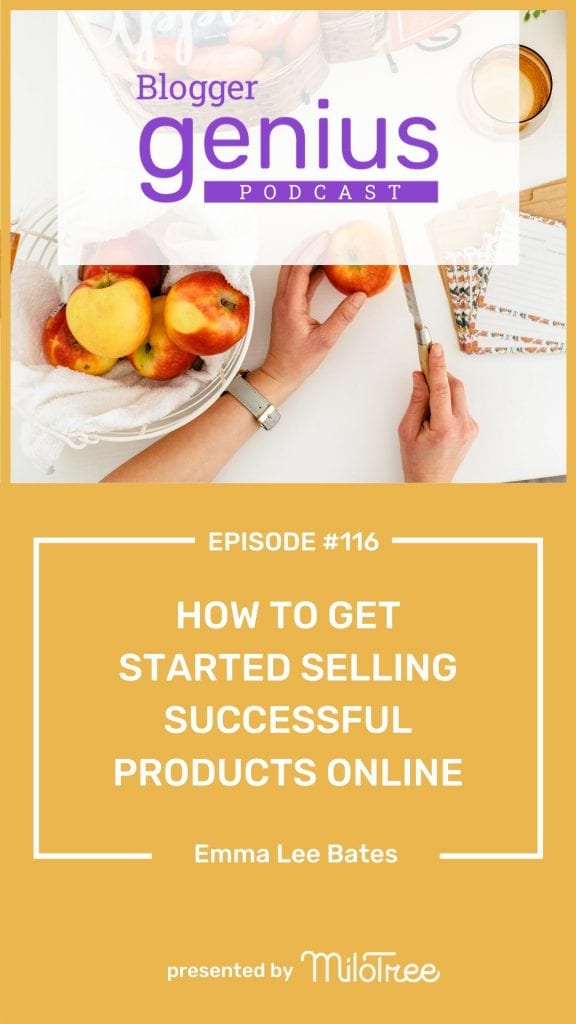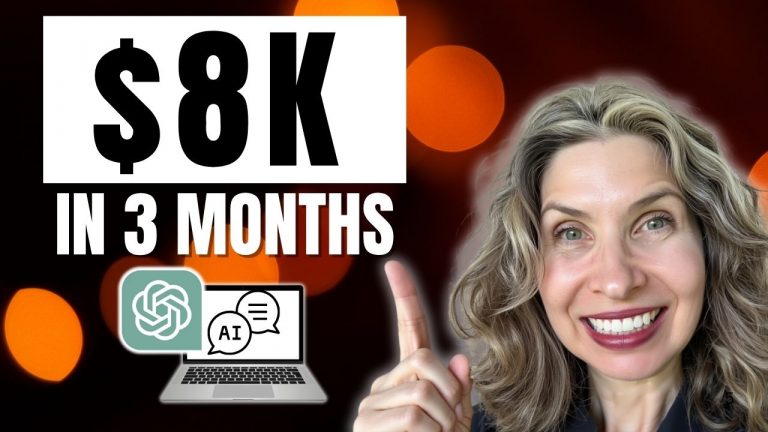#116: How to Get Started Selling Successful Products Online
If you are interested in how to get started selling successful products online, you’re going to love today’s episode.
I’m chatting with Emma Lee Bates, online marketing expert, about all things sales: landing pages, selling to your email list, trends in online marketing, and sales funnels.
If you struggle with selling or you just want to learn more about how to do it well, this is the conversation for you!
But, before we dive in to my conversation with Emma, I want to ask you a question: have you listened to 5 or more episodes of this podcast but you don’t have your own blog yet?
If so, you are not alone!
My husband and business partner, David, and I have noticed a trend among some of our listeners; a lot of you want to start an online business or a blog but you have no idea where or how to begin.
If the tech required for starting a blog has been holding you back, I have great news for you!
MiloTree is now offering blog start-up services! Just go to MiloTree/BlogStart to see how we can help you.
We know how overwhelming it can be to start a business if you’re not tech-savvy.
That’s why we decided it was time to help people get over the hump of getting their blog set up so they could move on to creating content, serving their audience, and developing products.
If you’re ready to make 2020 the year you finally start that business or blog you’ve been dreaming of for a long time, let us help.
Head over to MiloTree/BlogStart to get started.
We can’t wait to see what you build in 2020!

Table of Contents
Why You Should Be Using Tripwires
We’ve begun experimenting with tripwires on our site, Catch My Party, and I’m loving it.
For those of you not familiar with tripwires —a tripwire is a product you upsell to your audience when they sign up for your email list.
When someone opts in for your lead magnet, instead of simply sending them to a thank you page, the thank you page becomes a sales page of sorts.
On this page, you can upsell a product that is an obvious next step for the lead magnet they just signed up for.
Over at Catch My Party, we give away free party printables. We literally have thousands of free printables that anyone can download and print out.
So, if someone opts in to receive free printables for a Minecraft party for their kid, the thank you page offers them a Happy Birthday banner that they can personalize for just $5.
Tripwires are an easy way to bring in extra money for a couple of reasons:
- It’s a no-brainer purchase for the customer. Your tripwire is an obvious next step for them.
- It’s passive income. You set it up once and you’re done. “Hello, money in my bank account while I’m sleeping.”
- It requires no actual selling. You’re merely providing the person who already said they wanted your other products, with the opportunity to get one more thing that will make their life easier.
Using Tripwires to Train Your Audience to Buy From You
If you give away a ton of stuff for free on your blog, as we do on Catch My Party, your audience might start to depend on you for free stuff. And that can make it harder to sell to them later.
Whereas, if when someone signs up for your list, they get sent to a landing page with a tripwire, they can see right away that you also charge for some of your products.
The great thing is that when someone clicks the button to buy your lower-priced tripwire product, you are training them to click to purchase from you.
So, if they buy your $7 tripwire today, they are more likely to purchase your $25 product next month.

How to Write Successful Sales Emails
Let’s say you’ve been blogging for a little while now, you have a warm and active email list, and you want to sell a product to your list.
If you’re anything like me, you dread writing the sales emails.
And the reason I dread it? Because all the sales emails that I get in my inbox are super long and detailed, telling me all sorts of stories and information before they even get to the part about the product.
And I don’t want to do that.
My feeling is, if you’ve been on my list for a while, you probably already know, like, and trust me, so I should be able to just write the email, tell you about the product, and ask you to buy it.
If you are truly my avatar, I should know you well enough to know exactly what product you want and need, and I shouldn’t be bashful about introducing you to it or asking you to buy it from me.
The trick in writing sales emails, says Emma, is to write the way you normally do.
If you typically send your list a nice, long, 8-paragraph email once per week, then if you send three 2-paragraph emails asking your people to buy something, that’s going to feel very off to them.
So, write like you typically do.
Be warm and personable like you always are; don’t be awkward about selling. Be yourself and tell your audience about the thing that’s going to change their life… or at least make it a bit easier.

How to Write Successful Sales Pages
Have you noticed that the sales pages for online tools (such as email service providers or online course software), are always super short? Sometimes you don’t even have to scroll to see the entire sales copy.
And yet, when I go to a sales page created by an entrepreneur, I typically have to wade through scores of paragraphs, including videos, testimonials, tons of words about the incredible value this person is offering for the price, etc.
*To my listeners: would you email me at jillian@milotree.com and tell me how you feel about those super long sales pages? I seriously want to hear from you.
Emma shared that the reason for the novel-length sales pages is for the cold audience you may be driving to your sales page through Facebook ads. And indeed, if you are driving a cold audience to your products, it is going to take some space to convince them to buy from you.
That cold audience is going to need videos, plenty of testimonials, and your backstory in order to develop that “know, like, and trust factor” with you. They haven’t had the opportunity to get to know you through months of being on your email list.
For a warm audience, you don’t need nearly as much information. You need the basic information, the transformation your customer will experience as a result of their purchase, and a clear call-to-action to purchase.
Lastly, you need buttons. Lots of buttons.
Don’t place a buy button only at the very bottom of a page. If I have to scroll 25 times to get to a button, I am much more likely to click away before I get there. I want a button at the top, again after a bit of information, and again after more information.
Don’t assume anyone will read the entire page.
I want to click “PURCHASE” as soon as you’ve convinced me I need it. So, add a buy button every few paragraphs if you’re going to create one of the super long sales pages.
How Much Should You Charge for Your Products?
I think that setting prices is one of the most difficult parts of online business and definitely the piece that holds so many of us back.
How do you set prices? Do you set it at a price that more people can afford? Or do you price it higher so that your customers will also purchase other higher-priced products from you?
And is it true that the more people pay for your products, the more likely they are to actually use the products, and therefore, the more likely they are to personally experience the transformation you promised?
Emma firmly believes that when selling products, your customer should be at the very forefront of your mind. And if you are selling something that could transform her life but she can’t afford it, you are not serving her.
Always keep in mind where your customer is right at this moment and what she can afford.
Are there products worth hundreds or thousands of dollars? Yes, definitely.
And if your avatar is at a point in her life where she can afford to pay that, and it will deliver a transformation that will surpass the money she spent on the product, go for it.
But if the price is out of reach for the majority of your readers, it’s too high.
How to Think About Personal Branding
Branding is a hot-button topic in today’s online world. With everybody creating personal brands, how do you brand your blog, and how do you expand the branding to cover your products, etc?
Emma suggests keeping your personality in mind when developing your brand.
If you’re going to be growing an online business, you need to be present—front and center in your business. So, above all, be yourself.
Your people will be drawn to who you are. They will find you and they will stick around because they can see who you truly are. Don’t try to put on some fake persona.
Speak your truth. Be yourself. Serve your people well.
*There were so many things we couldn’t include in this post that Emma talked about. If you want to hear which shopping cart software that Emma (and we) recommend, listen in at 21:40. Emma discusses her own products and where she hosts her online courses at 24:00.
I know you learned a ton of amazing info from my conversation with Emma. I loved chatting with her and I hope you’ll check out all the great content that she offers on her own site.
And as always, please email me with any questions or comments on the podcast, and be sure to join me over in our Facebook group, where I go live every week to discuss the podcast and my biggest takeaways!
Read the transcript for “How to Get Started Selling Successful Products Online”
Imagine a world where growing your social media followers and email list was easy…
It can be with MiloTree!
Try the MiloTree pop-up app on your blog for 30 days risk-free!
Let your MiloTree pop-ups help you get to that next level by turning your visitors into email subscribers and social media followers on Instagram, Pinterest, Facebook, and YouTube.
Sign up today!
Install your MiloTree pop-ups on your site in under two minutes.
Sign up for MiloTree now and get your first 30 DAYS FREE!







